C+ Grooming, Clipping, & Cooling Down
1/17
There's no tags or description
Looks like no tags are added yet.
Name | Mastery | Learn | Test | Matching | Spaced |
|---|
No study sessions yet.
18 Terms
Name 4 reasons for grooming
Keep skin and coat healthy
Provide a massage, stimulating circulation and muscle tone
Improve appearance
Opportunity to inspect horse
Name 4 reasons for clipping
Allows horse to work easier during winter months with it would otherwise have a thick coat
Helps maintain condition to prevent excessive sweating
Allows for higher level of fitness to be attained
Makes cooling off and drying off following riding easier
Saves time and effort in grooming
Helps prevent disease
Improves appearance
When trimming what areas wouldn’t you trim?
The inside of the horse’s ears, horse’s whiskers
When may trimming be required
To improve appearance and tidy areas that grow particularly long and hairy such as the heels, and end of tail so they look smarter and less muddy
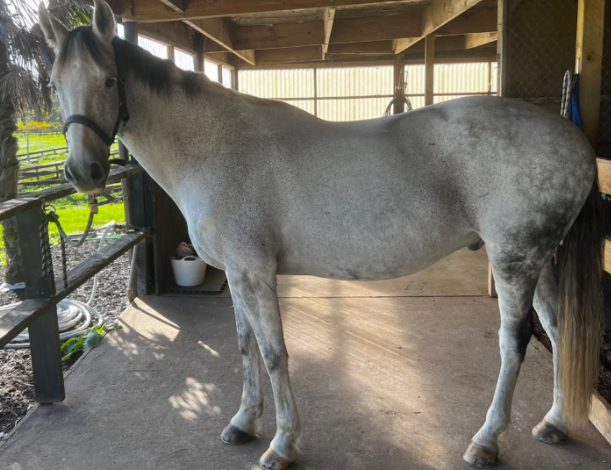
Name this clip and what it’s suited for
Full clip:
Suited to horses that are stabled or lives in a well sheltered paddock and provided extra rugs
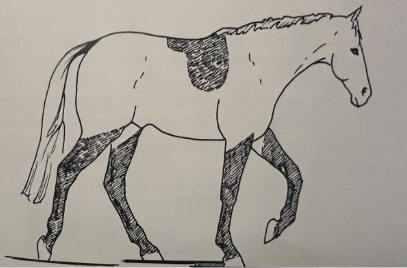
Name this clip and what it’s suited for
Hunter clip:
Offers warmth and protection
Saddle patch helps to prevent a scalded back
Hair on legs helps to protect against injuries and prevent cracked heels or mudfever
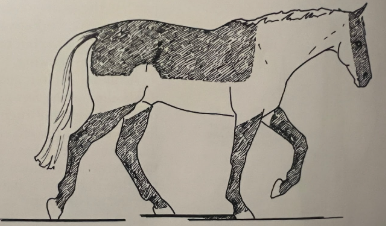
Name this clip and what it’s suited for
Blanket clip:
Useful for heavier coated horses in work who feel the cold easily if too much of the coat is removed
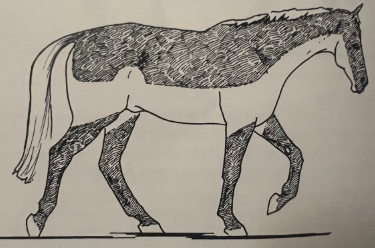
Name this clip and what it’s suited for
Trace clip
Suitable for horses living out in the paddock, removes the hair from area’s that would otherwise sweat freely but leaves the protection on the upper parts of the body
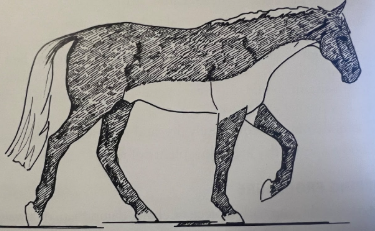
Name this clip and what it’s suited for
Belly clip
Suitable for horses not in particularly hard work and might otherwise have to be turned out wet at night
When should you clip?
end of March (after the coat has set)
How should your horse be prepared for clipping
should be clean and dry, mane plaited if having a full, blanket or hunter clip. Cover handy to throw over horse as clipping progresses
What clippers should you use when clipping?
usual electric type with the motor in the head. Smaller battery powered ones useful for the head
What should you have prepared when clipping
Power outlet
Residual Current Device (RCD): circuit breaker to cut the power incase of emergency
Oil: light machine type
Kerosene or plastic container
Soft brush to use on blades and keep air filter clean
Spare set of blades or plates
Grooming kit and tail bandage
Sheltered yard or well lit box
Haynet to occupy horse
Twitch to use if necessary
Assistant to calm horse and/or help as required
What should you wear when clipping
Overalls to protect your clothes, gumboots, tie hair back, head scarf sensible
What kind of day should you clip on?
Choose a warm dry day, allow plenty of time
Describe the process of cooling down a horse after strenuous/fast work
Pull horse up gradually, in a straight line and keep your horse balanced
Risk of injury pulling horse up suddenly, turning sharply or dropping the contact
dismount , run the stirrups up, loosen the nose band, loosen the girth and lift saddle to allow air to circulate, place a cover over the horses back and loins and walk quietly for 10 minutes or until he stops blowing
Hose or sponge down, scrape off the towel dry. To avoid him catching a chill quickly repace cover over back and loins
A sweat rug underneath will speed up cooling and drying time
Lead again for another 10 minutes to allow muscles to cool and remove lactic acid
Only small sips of water. Don’t not allow horse to have a big drink or feed until horse has cooled down and respiration back to normal
Next day, check for injuries and trot out in hand to check for soundness
Groom to remove any mud or sweat and give him the day off
Describe the process of cooling down a horse after a “normal”/”regular” ride
Always try bring your horse in cooled off following riding (not seating or blowing)
If hot under saddle, loosen the girth and lift saddle to allow air to circulate, leave saddle on while you tend to your horse, prevents back from cooling too quickly which could result in a chill
Tie up horse, remove bridle, pick out feet & check shoes
Brush over, paying extra attention to behind the ears, nose (where the noseband goes) between forelegs, under stomach and between hind legs
Remove saddle, if damp, rub rigorously with a towel then brush
Brush girth area thoroughly
Place rug back on.
Describe the process of cooling down a sweaty pony in cool weather
Doing nothing not sensible, can catch a chill
Cover the forehand while working on the hind quarters and vice versa, use a sheltered area
Some methods include:
Dry him off while still keeping him warm:
Cover him with an antisweat or woollen rug, stuff handfuls of straw underneath
The straw creates space that allows air, warmed by body heat to circulate and dry the coat
Walk pony around if weather permits
Let the pony roll in clean sawdust, bush the debris off
Sawdust will soak up the moisture from the coat
Rolling will take care of the itchiness
Cover with an antisweat or woollen rug, groom when dry
Rubbing the coat with a towel can speed up drying process
Use warm water and sponge to remove the worst of the sweat
Dip sponge in warm water
Squeeze out excess
Rub the small area that is sweaty, rinse and repeat